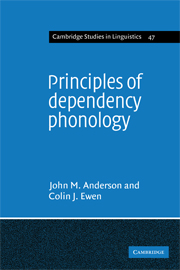7 - Dimensions of phonological representation
Published online by Cambridge University Press: 04 August 2010
Summary
In Part III we attempt to draw together various aspects of the preceding discussion, and we also touch on some issues which are relevant to the assessment of any model of phonological representation, but which have not as such been considered so far.
Chapter 8 is devoted to the relationship between representational and other aspects of phonological theory; in this chapter, however, we consider the relationship between segmental and suprasegmental representation, and the nature of the ‘segment’ itself, together with the nature of the distinction between lexical and utterance phonology. The organisation of the chapter is from small to large: we begin with a discussion of relationships within the gesture, i.e. the smallest structural units within which phonological primitives are organised, and end with suprasegmental structure.
Intragestural relationships
As we noted in §1.3, the framework of SPE is minimally componential in that there is no attempt to organise the phonological primitives into subgroupings within the segmental feature matrix, nor is there any variety in the type of relationships holding between the primitives in the model; i.e. all segments are characterised by an unordered set of features, each of which can have only the value ‘+’ or ‘−’, at least phonologically. The notion of gesture provides the sub-grouping lacking in the SPE model (see the discussion in the introduction to Part II); here we want to look in rather more detail at the way in which the incorporation of dependency relations overcomes some of the other problems associated with minimal componentiality.
- Type
- Chapter
- Information
- Principles of Dependency Phonology , pp. 255 - 280Publisher: Cambridge University PressPrint publication year: 1987



